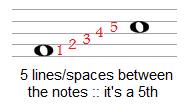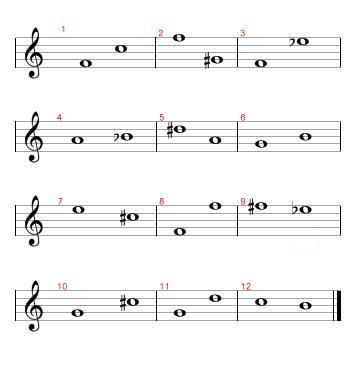Intervals are a VERY basic part of music, and anyone who calls themselves a musician should be able to recognize them. Whether or not they know the proper names for those intervals isn’t terribly important… recognizing them by sound is what matters. However, knowing their names IS a very handy thing, especially when you’re trying to communicate with other musicians via spoken or written word.
The name of an interval has two parts: the quality and the size. The size is the easy part. You can find it by simply counting the number of letters between two notes. C to D is a 2nd, A to E is a 5th, B to F is a 4th… it’s pretty simple. You can also count the number of lines/spaces between the two notes on a music staff, as shown in the following example:
The quality is the trickier part. The 5 main qualities for intervals are major, minor, perfect, diminished, and augmented. You can theoretically have things like double diminished or triple augmented, but the only place you’re ever going to see those is on your music theory tests. So which is which? The best way to figure all that out is to just learn all the intervals in the major scale, then compare everything to that.
We’re going to use the C major scale, which consists of the notes C D E F G A and B (all the naturals). C is the root, or 1 of the scale. D is the 2nd note. It is a major 2nd above C. E is the 3rd note. It’s a major 3rd above C (see the pattern?) Next is F, which is a perfect 4th abov– wait, perfect?! Yeah, so much for that pattern huh? Well, it’s still not complicated. The 4th, 5th, and octave are the only perfect intervals, everything else is a major interval.
So all together we’ve got the root, then a major 2nd, major 3rd, perfect 4th, perfect 5th, major 6th, major 7th, and a perfect octave.
Alright, but what about minor, diminished, and augmented? That’s simple too, but people often get confused here, so pay attention:
- If a major or perfect interval is expanded by a half step, it becomes augmented
- If a major interval is reduced by a half step, it becomes minor
- If a minor or perfect interval is reduced by a half step, it becomes diminished
Keep in mind that by expand/reduce I mean adding sharps, flats, or natural signs to the EXISTING LETTERS. If you change the letter name of a note, you are changing the size (number) of the interval.
That’s practically everything you need to know! Let’s just do a couple of examples to make sure you’ve got it.
F to E♭… F G A B C D E… so it’s some type of 7th. The F major scale has a an E in it, so F to E is a major 7th. We’re going to E♭, so that’s one half step lower, which means it’s a minor 7th.
C♯ to A♭… C D E F G A… so it’s a 6th. C♯ major has an A♯ in it, so it’s not a major 6th. We’re going to A♭, which is 2 half-steps lower, so we’ve got a diminished 6th.
Is all this making sense?
Intervals can also be inverted! Let’s say you’ve got a major 6th interval going from A up to F♯. If you take that A note and move it up an octave, you’ve now got a minor 3rd interval! It’s easy to figure out the inversions. All you need to do is subtract the number of the interval from 9… that’s your new size. To figure out the quality, just remember these simple rules:
- Major intervals become minor intervals and vice versa
- Augmented intervals become diminished intervals and vice versa
- Perfect intervals remain perfect
You may have realized by now that there are lots of intervals that sound the same… like a diminished 5th and augmented 4th, or a minor 7th and an augmented 6th. We call these “enharmonic intervals”. What’s the difference? Well.. it’s just technical. They sound the same. It’s really all about keeping the music organized and easy to understand.
Now it’s time to put all this stuff to the test. Below is a little test. The answers are linked right below. I know this stuff may seem tedious right now, and it will most likely take you a little while to figure everything out, but it does get easier with time. Eventually you will simply know that E to G♯ is a major 3rd and A to D♭ is a diminished 4th.


